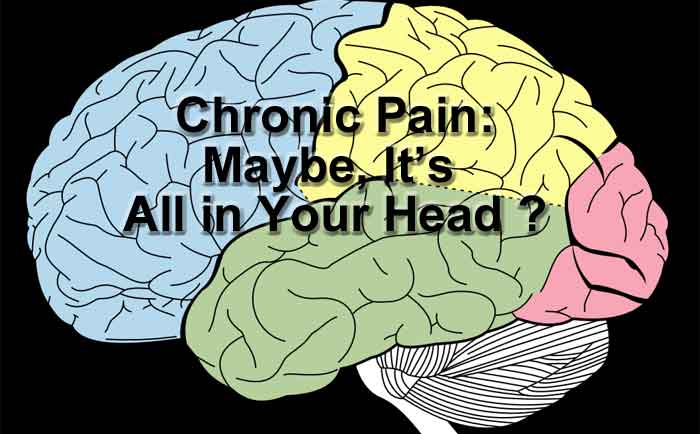If someone, especially a physician, were to ask you this question, you may be offended. The reason you may become offended is you interpret this statement as the physician thinks you are crazy. However, all pain you feel, you do feel it in your head. I know what you are thinking, “…but my knee hurts or my back hurts, that is not in my head.”
As many of you have heard me say over and over, once you relax the brain, the body will follow. In today’s newsletter I will discuss in more detail why the brain feels the pain, not the body, how the brain increases the pain, and tools to relax the brain and help you reduce the pain.
Why Does the Brain Feel the Pain?
If you have had a surgery, or know someone who has, you know the doctor places you under general anesthesia before they begin to cut on you. When a person has a joint replacement, while under general anesthesia, the surgeon can take a saw and cut your leg into two pieces without you ever feeling it. Imagine if the surgeon did this without general anesthesia! You could not have endured the pain. So, how does general anesthesia do that?
Throughout your body, you have pain receptors that report back to the brain. If your knee hurts, a message is sent to the brain that your knee hurts. The brain then anticipates the pain every time you move a certain way, or even the thought of moving at all will cause the brain to contract the muscles around the affected area and increase the pain. Think about this: the last time your back hurt, do you remember how you would stand up? Typically, when a person is feeling back pain, they stand very gingerly, and then slowly as they come to a standing position, they begin to feel less discomfort and finally stand all the way up.
If someone asks you to sit down, what is your first thought? “Oh no, it is going to hurt when I stand back up.” Could you feel your back tighten? You had not even sat down, yet you could begin to feel the pain of standing back up. Some may take pain pills or muscle relaxers for the pain and that will reduce the pain, but understand you only reduced the pain in your mind. If there is structural damage, nothing has changed. Once the medications wear off, the pain will return and that sets off chronic pain. Our health care system has trained physicians and others to treat acute pain, not chronic pain. Acute pain occurs when you first feel the pain. Chronic pain occurs when you have the same pain for weeks or months.
I recently was loaned a book by one of my clients,” The Way Out” by Alan Gordon, LCSW. Alan Gordon is a psychotherapist and founder of the Pain Psychology Center in Los Angeles. He developed the Pain Reprocessing Therapy (PRT) which is a mind-body program that eliminated his own chronic pain. Through his work he has shown that while chronic pain feels like it is coming from the body, it is likely coming from misfiring pain circuits in the brain. If you are interested in learning more about his work, I would suggest reading this book. It is a short read and should not take you long to finish it.
How the Brain Increases the Pain
As I said earlier, when the brain anticipates pain, it contracts the muscles around the affected area which may cause more pain. This is due to the “fight or flight process” which is built into our brains for security reasons. Our pain becomes the saber tooth tiger that is typically used in the example of the “fight or flight process.” In this case, we cannot escape from the pain since it is internal and not an external force. Therefore, we must fight it and that triggers the muscle contractions around the affected area. When using my “Stretch n’ Release Technique” you can allow the brain to calm down and relax the muscles which will reduce the contractions around the painful area. The self-massage reduces the build-up of lactic acid which makes the muscle hard and increases the pain as well. Once the muscle is soft and the brain is relaxed, the pain will decrease. This is why I say that stretching is more emotional than physical. The muscles are only reacting to the emotions you are feeling.
How to Reduce the Pain
When doing my “Stretch n’ Release Technique” correctly, the softening of the muscles first will make it easier to stretch the muscles later. As you do the self-massage to soften the muscles, remember to breathe out and not apply too much pressure. If you cannot breathe out due to the pain, or the pressure is too great, reduce the pressure, breathe out, and let the muscle relax. Move slowly up and down the affected area of the body. Give yourself a chance to feel your body and observe what it feels like. For most of you, your body is the only body you truly feel, so whatever it feels like is normal to you. However, as you practice the self-massage, you will discover a different feel to your body and it will feel much better.
When doing the stretching part of my “Stretch n’ Release Technique” it is important to understand that the site of the pain is rarely the source of the pain. If the pain is on the backside of your body, then the cause is usually on the front side. For instance, when someone has back pain, most therapists and trainers have them stretch leaning forward. Usually, people feel back pain when they stand, not when they sit. Bending forward to stretch your back is like the seated position and that is not when you feel pain. When you stand, you extend the front of your thighs and inner thighs which is most likely causing the back pain. Bending forward will never solve your back pain and therefore the pain becomes chronic. Over time it can lead to bulging or herniated discs and pinched nerves.
When stretching, always inhale fully then breathe out as you go into the stretch and feel the muscle stretch. This does not have to hurt, but it should feel like it is stretching. Do not worry about how far you go in the beginning as you are working to let your brain see the movement is safe. If you try to force the stretch, your brain will contract the muscle to prevent the pain and you will never get any better. Holding for five seconds prevents the automatic stretch reflex from happening. The automatic stretch reflex is a protective reaction built into our brains to prevent an injury to our body.
The repeating 10 times is just to let the brain see it is safe and you will notice that each time you do the stretch, it gets better and easier. Do not worry about how far you bend as the range of motion will take care of itself. Once the brain knows you are safe in the movement, it will release the muscle and the muscle can extend to its full range.
In using my technique, you are allowing the brain to release the muscles versus the brute force that you see in many gyms and physical therapy. It takes practice, but once you get it, and you will, your body will feel more energized and vibrant.
Shoulder Horizontal Flexion Stretch
Stretching is more about feeling the muscles letting go than forcing them to stretch. If you are forcing the muscle, you could be doing strength training, not stretching. Make sure you are feeling the intended muscle stretching. If not, the form could be wrong. Holding for 5 seconds allows the brain to release the muscle before it senses any danger. Repeating the stretches 10 times allows the brain to learn it is safe for the muscle to move that way.
Shoulder Bent Arm Horizontal Flexion Stretch
Don’t forget the Tennis Ball Massage!
Softening your hips and back is easy when you use the tennis ball. Just lean against the wall and apply enough pressure to feel the painful area. The temptation is to press harder but resist it. Instead, breathe out and allow the muscle to soften under the ball. Then move to another spot and repeat. Continue doing this until most of the painful spots are gone. Check out previous newsletters to see the video.
Want to Talk with Me Directly? Start Here
We’re happy to offer you a complimentary 30-min virtual consultation so you can experience this for yourself. Schedule your introduction to Stretch n Release now.
About The Muscle Repair Shop
Drawing upon his personal experience as a former competitive athlete turned wheelchair, obese, and chronic pain sufferer, Muscle Repair Shop Founder Butch Phelps decided to take his health into his own hands when at the age of 36 he was told he might not make it to his 40th birthday. Applying balanced nutrition advice from his doctor along with a sound exercise program, he went from 315 lbs. to 180 lbs. Motivated by his experience, he then acquired degrees in advanced therapeutic massage and aging sciences to help people eliminate chronic pain. This included applying his expertise in how people age, including the effects of dementia, anatomy, psychology, and the day-to-day struggles living as an older person to his practice and development of The Muscle Repair Shop’s one-of-a-kind Stretch n’ Release Technique.
Available through in-office and virtual coaching treatment sessions, this unique combination of stretching and breath work teaches the brain to release the emotional side of muscle tension and pain allows clients to find lasting relief and healing from stiffness, aches, injuries, and chronic pain. The at-home exercises come with customized instructional videos and virtual or in-office support, allowing clients to enjoy and experience life and sports as they did before limitations slowed or curtailed activities.


